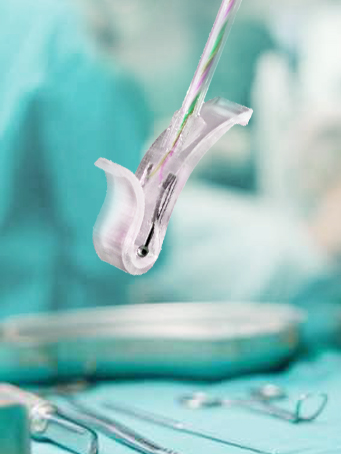Thyroid disorders affect millions of people worldwide. In many cases, surgical treatment is necessary and often the only solution. For example, where a goitre, an enlargement of the thyroid gland, has formed, or if malignant changes are found, surgical intervention is recommended.
In continuous recurrent laryngeal nerve monitoring, the vagus nerve is stimulated so as to monitor and protect the recurrent laryngeal nerve in the surgical area.
The delta-electrode is placed around the vagus nerve and thus always keeps contact with the nerve and delivers stimulation pulses at the defined rate and threshold.
The distinct advantage of the electrode is its delta-like shape and form factor. The shape enables the electrode to be positioned optimally on the nerve and prevents the electrode from slipping or sliding off. As a result of the constant contact with the vagus nerve, technically-induced signal attenuation and even signal loss can be avoided. The surgeon can thus immediately see if the recurrent laryngeal nerve is at risk and can act before a reduction in nerve conductivity becomes an irreversible vocal cord paralysis.
The ALM Tube is ideally suited for obtaining the best possible EMG signal recording from the vocal cords. Its multifunctional combination of a clear PVC ET tube and a surface electrode with eight long recording contacts offers the ultimate signal stability. Due to its all-around 360° surface sensor coverage and the extended length of the 8 sensor pads, the ALM Tube provides reliable signal recordings independent from tube shift or rotation. The surgeon benefits from easy placement of the recording electrode. Thanks to the flat surface and smooth bevelled tube tip, trachea injuries can be avoided.
Using intraoperative nerve monitoring, and depending on nerve performance during the procedure, the surgeon has the option of ending the procedure after a unilateral thyroidectomy if the results from nerve monitoring are inconclusive or sub-optimal. After successfully maintaining the ipsilateral function of the recurrent laryngeal nerve, the surgeon is able to continue operating contra laterally with a higher degree of confidence. This method helps to identify nerve impairment at an early stage and therefore avoid bilateral vocal cord paralysis.
In the case of surgical intervention where partial removal of the thyroid gland (subtotal thyroidectomy) or its complete removal (total thyroidectomy) is required, these procedures carry a risk of damage to the vocal cord nerve, the recurrent laryngeal nerve. If the recurrent laryngeal nerve is impaired or damaged, this can have serious consequences for the patient. Impairment or damage to the recurrent laryngeal nerve can result in short-term hoarseness after surgery or even lead to permanent bilateral vocal cord paralysis.
Intraoperative neuromonitoring >> during thyroid surgery enables the function of the recurrent laryngeal nerve to be monitored throughout. The continuous monitoring process enables the surgeon to make informed decisions during surgery. Following surgery, a definitive statement can be made as to nerve function. The ultimate goal of recurrent laryngeal nerve monitoring is to minimize nerve impairment and to avoid bilateral vocal cord paralysis.
During the procedure, the surgeon is able to use a hand probe to locate the recurrent laryngeal nerve, map it and check its function. Nerve function is therefore recorded both at the beginning and at the end of the operation. In addition, continuous neuromonitoring allows for both audible and visual feedback of the nerve function in real time and enables the surgeon to react quickly to avoid vocal cord paralysis.
